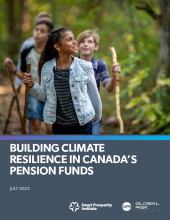Canadians are directly connected to the drivers and solutions for climate change as consumers and voters, and as savers, investors, and pension holders. But while Canadians are increasingly concerned about the climate crisis, many are unaware of how their retirement savings may be backing industries or sectors with significant climate risks.
Money managed on behalf of Canadian workers through their pension funds is often being directed to areas that are misaligned to climate objectives, such as companies and infrastructure that are ramping-up fossil fuel production.
Canada’s big eight pension funds collectively manage around $2 trillion in assets. With the potential to shape global markets, this enormous sum must be invested wisely, protecting beneficiaries against accelerating climate risks, including those related to an abrupt transition to a low-emissions economy.
To this end, Canada’s largest funds have committed in recent months to greening their portfolios, including by adopting net-zero greenhouse gas emissions targets for 2050, in-line with global momentum behind sustainable finance.
Reaching these net-zero targets will require underlying assets to be climate-aligned with portfolio companies having credible net-zero plans of their own. But with no binding requirement to track progress on these voluntary commitments, and no standardised climate-related disclosure for pension funds, there is a significant transparency gap in determining what type of progress is being made.
This new report, Building Climate Resilience in Canada’s Pension Funds, reveals the best practices that pension funds can adopt to strengthen climate resilience, building on their existing know-how to guard against other types of risks.
Key recommendations of this study include:
-
Pension fund administrators should continue to adopt net-zero emissions targets for 2050 as a means to build climate resilience, and thus invest only in climate resilient areas and companies with credible net-zero plans as a requirement of their lending decisions.
-
All portfolio assets must demonstrate a plan to reach net-zero emissions by mid-century. Commitments around green or transition assets cannot compensate for assets that do not meet this requirement.
-
Pension funds should have their own net-zero targets vetted through third-party certification standards.
-
Pension funds should require climate-related disclosure in line with best practices and should also require their portfolio companies to have their climate targets vetted by third-party global initiatives.
-
Governments and international financial bodies have a role to play in mandating climate reporting obligations and should include a requirement to disclose metrics needed to track progress on all climate commitments.
Net-zero targets, taken together with transparency commitments, support for investment enablers, and alignment with global credibility standards, will ensure that pension fund administrators can better orient investment and engagement activities with the type of future for which we are all saving.






